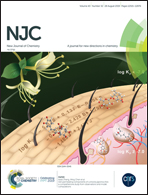Modification of CuCl2·2H2O by dielectric barrier discharge and its application in the hydroxylation of benzene†
Abstract
CuCl2·2H2O powder was modified by a dielectric barrier discharge (DBD) plasma at room temperature and atmospheric pressure (CuCl2–DBD). And the catalytic activity for the benzene hydroxylation reaction using CuCl2–DBD as a catalyst was investigated. The CuCl2–DBD samples were characterized by XRD, SEM, TEM, BET, XPS, FT-IR, and TG-DTA. The results demonstrate that after DBD plasma treatment, crystal H2O and about 50% of Cl in CuCl2·2H2O were removed, and the amounts of Cu and O increased on the surface of CuCl2–DBD. CuCl2·2H2O with a large flat regular geometric shape was changed into small particles with the average particle diameter less than 50 nm; the specific surface area decreased from 16.1 m2 g−1 to 9.4 m2 g−1, and the pore volume increased approximately 45 times. However, the crystal structure and the H3 type mesoporous structure of CuCl2·2H2O were still retained after plasma treatment. The DBD plasma modified or etched the surface of CuCl2·2H2O, and changed the amounts of elements on the surface. This surface change makes CuCl2–DBD insoluble in polar solvents. For the benzene hydroxylation reaction, CuCl2–DBD exhibits a higher activity and selectivity than CuCl2, in particular CuCl2–DBD can be recycled and reused. Under the optimized conditions, the yield and the selectivity of phenol were 19.1% and 95.6%, respectively. The activity of the CuCl2–DBD catalyst remained basically unchanged after repeated use four times.



 Please wait while we load your content...
Please wait while we load your content...